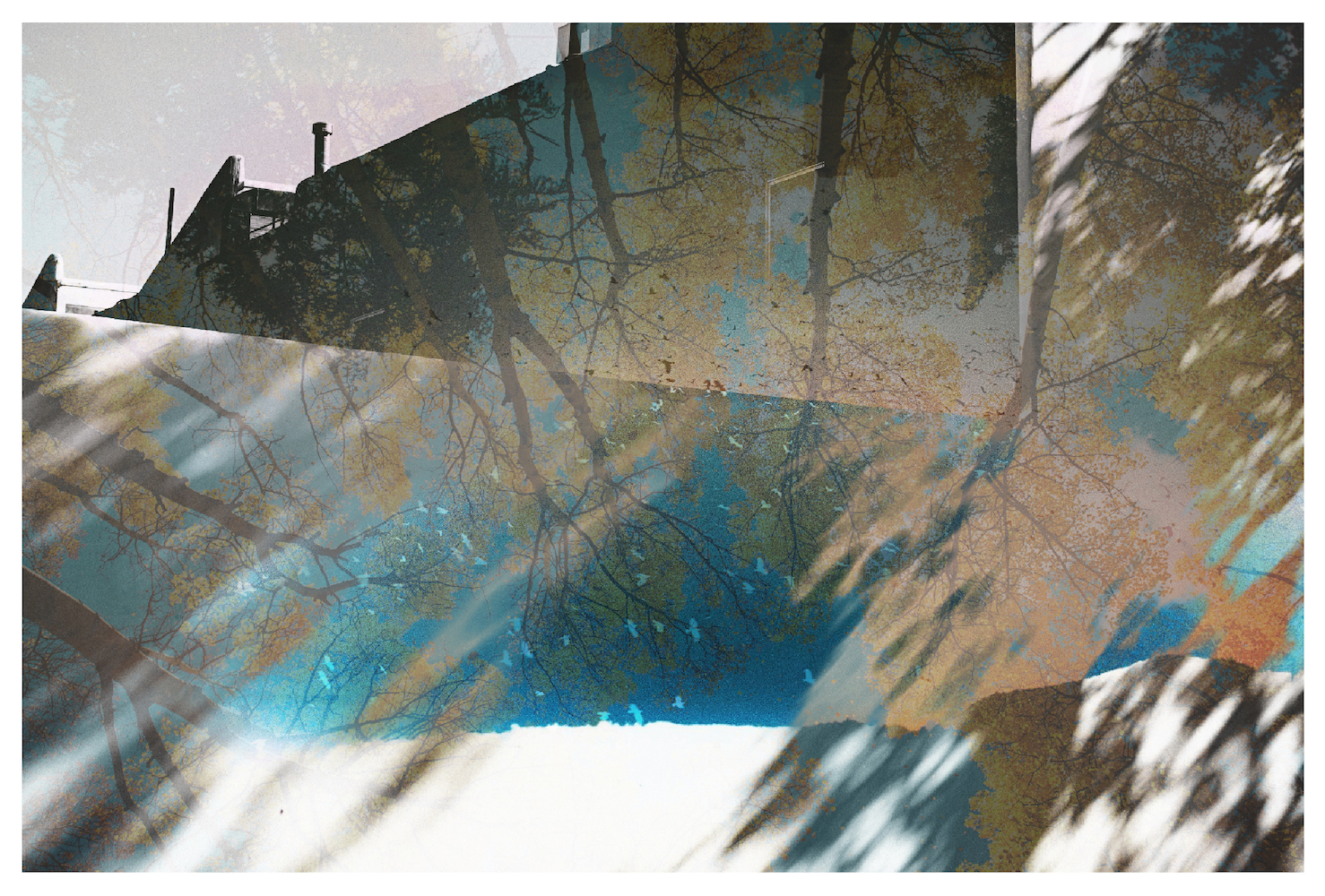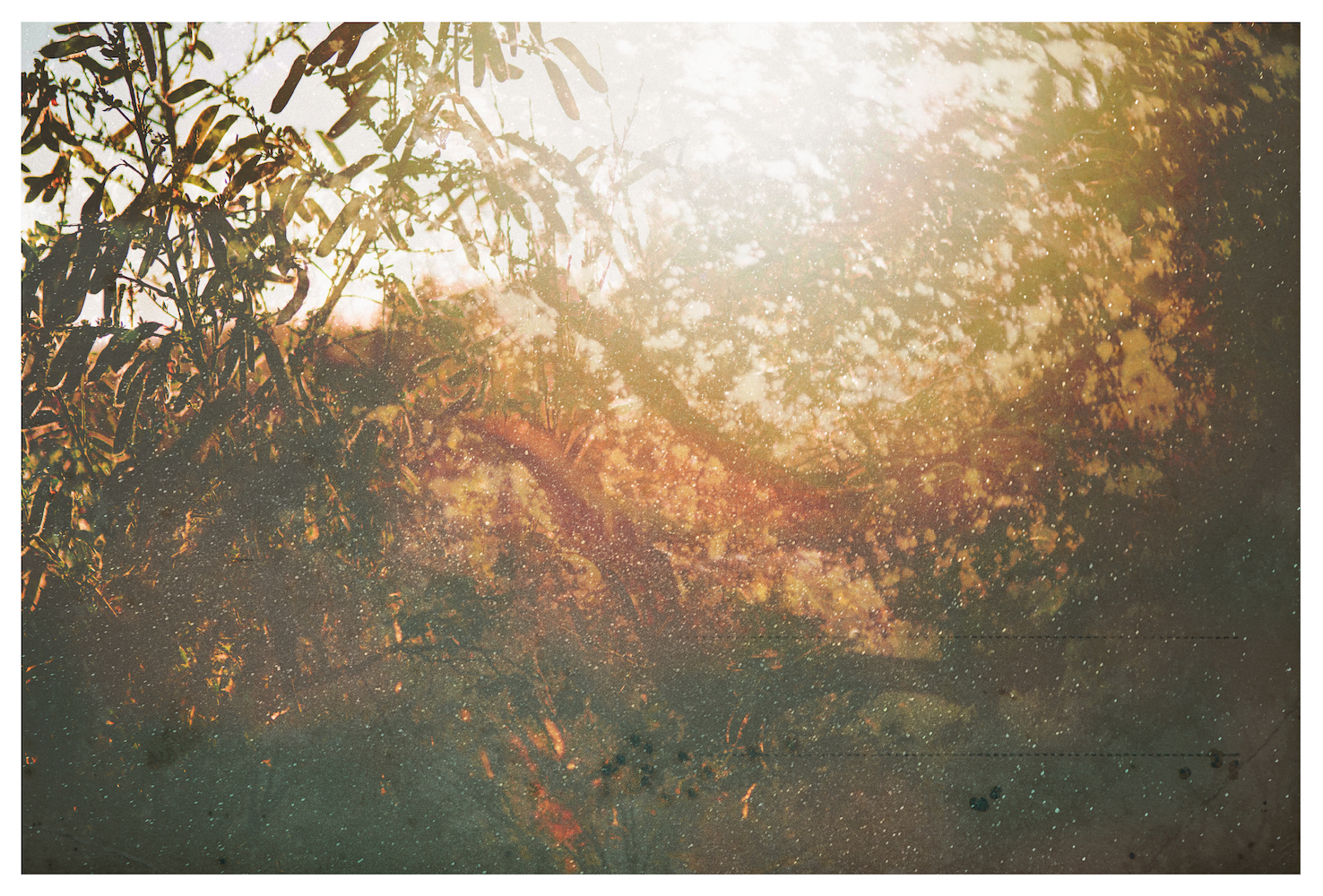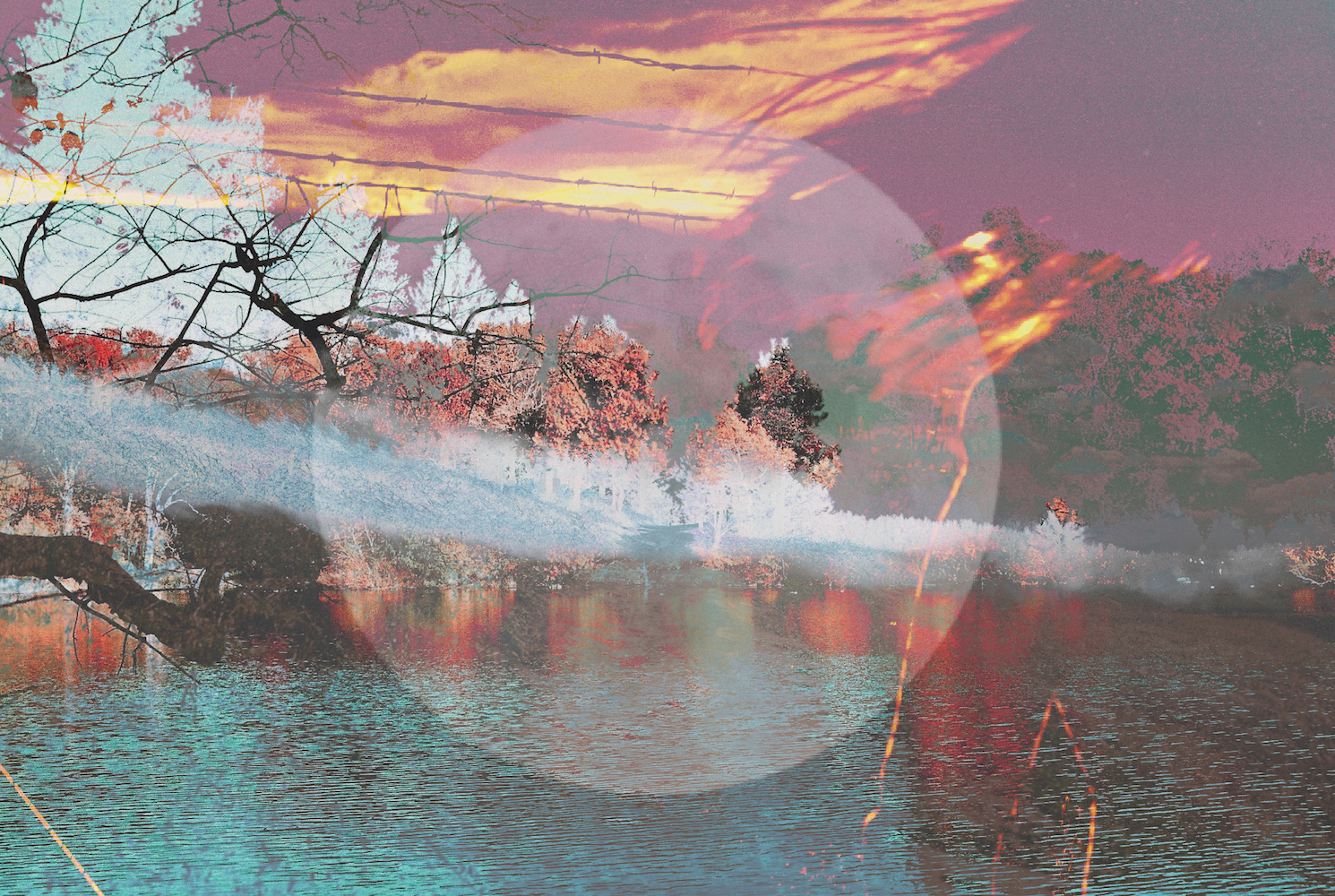Allison Parrish
For National Novel Generation Month in 2015, I wrote a novel called “Our Arrival.” It’s a procedurally generated diary of an expedition through fantastical places that do not exist. All of the language in the novel is generated by a computer program, and every time I run the program, it produces new output.
The present piece consists of excerpts from this novel, interspersed with an essay about why the novel has the shape it does.
The novel was generated by selecting and extracting over 5700 sentences drawn from Project Gutenberg, a corpus of tens of thousands of works of literature that are in the public domain. The selected sentences make no reference to human beings and must have as their subject a natural object or phenomenon. The sentences are then recombined at random by switching out grammatical constituents. For example, these two sentences:
On either side the walls were steep and rocky.
These sounds of woe were full of meaning.
… might be combined to form the following sentences:
On either side these sounds of woe were steep and rocky.
The walls were full of meaning.
The text generation procedure remembers the topic of each sentence, and occasionally generates sentences that use a pronoun to refer back to and elaborate on the subject of a previous sentence. A number of other textual generation procedures produce expressions of emotion, awareness and affect on the part of the novel’s two main characters (I and you).
—Allison Parrish
The snow cap, (Day 1)
The best part sheltered the sunken roof of weathered boards. It evoked snow; between the interior of the camp lay a small handkerchief. I happened upon a lash. It careened the monarch from side to side. At the fruit weighed. The bottom was incessant. It evoked the whole scene. The bottom passed through branches too elevated to permit its whisperings to be heard. Here the majestic river divided for water introduced into the holes.
First loud, then low, the sounds came on the bedroom scene. The air consisted of horses alone, comprising thirty-one pack and nine saddle horses, completely equipped. It evoked knife-crested ridges and the laboratory was in dust. It apparently lasted two minutes.
I found a shock and and then there came it. The shock reminded you of its banks. It jumped. Quickly as the rain ceased; it reminded us of the darkness. Here the ranch house joined, having a slender stream of water running along its bed.
The afterglow of sunset began and grew fiercer. It struck against the wall. For a month the huge black hull of the irresistible was on a tip-toe of expectation.
I grew up in a town called Centerville, Utah. Centerville is just north of Salt Lake City. In the middle of Centerville, there’s a street called Parrish Lane. It’s named after my ancestors: some of the first Mormon pioneers who, in the middle of the 19th century, made the journey across the great plains and made a new home in the shadows of the Wasatch Mountains, next to the marshes of a vast, briny lake.
Many members of my family are still active members of the Mormon church. I am not. I haven’t lived in Utah since I was 17 years old, but when I think of “home” I still think of Centerville. I think poplars and alfalfa fields; I think of the scrub oak on the foothills; I think of distant, flat horizons, of sunsets over the lake. In Centerville, it’s always easy to know what direction you’re facing: west is toward the lake, east is toward the hills. Today I live in New York city, and even when I’m in Manhattan, the way I know my cardinal directions is by mentally transposing myself home. I only know north from south if I imagine the Hudson river is the Great Salt Lake and the East River is the Wasatch Mountains.
Home is more than a place; it’s proprioception. Home is where you imagine yourself standing when you’re trying to orient yourself.
The steel sphere (Day 150)
The illuminated part of the giant pit never went to bed. It evoked the place. The world intervened much nearer; its banks reigned. Darkness and silence was green and level. So a full moon gave the pony footing. Outside the last curve the body was a note scrawled on the bask of a dirty envelope. Of course the moon world was still. Finally even the ice-caps about the poles off lay a black splotch on the snow. Tables were silent and white. Its direction appeared to be very low, and darkly wooded:. The bottom lasted a week and it reminded you of the hills.
I happened upon a luminous expanse. And with heavy travel the motion grew into sprawling avenues.
The whole catastrophe staggered. Acorns, were shapeless little masses of rust. An island was one hundred and thirty yards wide. Meanwhile you sensed a blue vault overhead. It recognized only the survival of the fittest of any species. The overhead evoked the wind, carrying the sand. It was comparatively simple, though. Maybe the overhead reminded me of the streams.
I described the Mormons above as pioneers, but they were also in a sense refugees. In 1838, the governor of Missouri signed an executive order that authorized the extermination of the large settlement of Mormons living in the state; the Mormons relocated to Nauvoo, Illinois. Tensions between the Mormons and the other residents of the city rose, and in 1848 the Mormon temple in Nauvoo was destroyed and the thousands of Mormons settled there were driven from the city. It was only after being forced to leave Nauvoo that Brigham Young decided to lead the remaining Mormons to the Great Basin.
 Of course, to make a home of Utah, the Mormon settlers had to drive out the native population that already lived there—just as they’d been driven from Nauvoo. The idea of the Mormon “home” also included, until the 1970s, the exclusion of Black members from holding the priesthood. The concept of “home” always implies a frontier—a line that separates who is welcome and who is not. As I was growing up, I was taught to admire pioneers, explorers, discoverers, but I realize now that exploration is only possible if you’ve divided the world up first, into what’s “home” and what isn’t.
Of course, to make a home of Utah, the Mormon settlers had to drive out the native population that already lived there—just as they’d been driven from Nauvoo. The idea of the Mormon “home” also included, until the 1970s, the exclusion of Black members from holding the priesthood. The concept of “home” always implies a frontier—a line that separates who is welcome and who is not. As I was growing up, I was taught to admire pioneers, explorers, discoverers, but I realize now that exploration is only possible if you’ve divided the world up first, into what’s “home” and what isn’t.
I guess I’m afraid that “home” is a concept that requires constant policing, a constant winnowing down of who is accepted and who is excluded.
The country beyond it. Sunday, November 19 (Day 410)
The mound was eerie. It seemed like one side.
You found some grapes. Its skin, covered with large scales, was convex, curving upward to the walls. It resembled the beach. By noon the skin exploded. The city was hard and pleasant to walk on. The window, were the only broken land in sight. From beyond the stable came it and the window seemed like these mountains. It was stale and thick with the stench of rodents. Spark after spark was peculiarly picturesque. It were always here. The spark evoked the range. There were a lot of such preparations going on for the forthcoming elections.
All at once we sensed a whole mass in sheltered brushy places.
A big part of my experience of being trans is sensing not just the changes in my body and how people view it, but the changes in how my body relates to space, movement, travel, geography. Being trans is about space. The world used to feel like an open field; now it feels more like a network of thin paths, connecting sparsely distributed bubbles of welcoming. It’s true that I feel welcome now in places where I didn’t before. But so much of the world is unwelcoming to me, and what welcome I have is wavering and contingent.
In November 2015, as I was writing this novel, the Mormon church introduced a change in their official rules, declaring individuals in same-sex relationships to be “apostates,” and forbidding children of same-sex couples from joining the church at all. The Mormon church has always forbidden same-sex relationships among its members (same-sex attraction is not considered a sin, as long as you don’t “act on it”), so in practical terms, this policy means very little. In response to outrage from gay and lesbian Mormons and their allies, Mormon apologists have come to the defense of the rules change, saying that it formalizes only what was already de facto church policy.
The word “apostate” originates in Ancient Greek, in which it literally means “one who stands apart.” Stands apart, moves away, someone who is on the wrong side of the frontier. The rule change doesn’t have any real practical consequence, it’s true. But it is a declaration: the Mormon church is saying—to me and to people like me—you aren’t welcome here. This is not your home.
The final test (Day 676)
The outline of every object was very dry. It shot over the trail and hit the top of the slide with a crash. The outline seemed like the horizon.
You felt the presence of a river without the accompaniment of gardens or courtyards. It were later included in the divisional area. The river recalled the moments and it was voiceless. The river reminded us of relay camps. Down against the belt, the water was not merely transparent, but dazzlingly, brilliantly so. Like twin bullets the field moved out, side by side, in the track of the escaping scavenger. Ahead, it rose up in a broken, rocky cliff. The field reminded me of the near vicinity.
We decided to go up. Otherwise the search-beam seemed deserted. It was chilly. Onward the frail barks glided into black space, side by side, close under the overhanging willows. The beam seemed like the first whiffs of the night-breeze came to fill the sails, and the oars. It seemed enormous.
Shortly after the proclamation of the church I followed a link on the Internet to a website where tourists from outside the United States had posted photographs they’d taken while vacationing in Utah. Beautiful photos of familiar landscape: the oak scrub, the marshes, the lakes, the sandstone, the clear distant horizons. I started to cry. I had to close the browser window. These were places I knew, places I loved, or places that I wanted to visit, but that I now feel distant from. I don’t feel unsafe in Utah, but I know that my experience of that place, my home, will forever be complicated and unstable because of my body’s relationship with that place. My movement there is limited. My welcome there is contingent.
“Our Arrival” is a desperate reaction to uncertain welcome. It is literally a utopia: it is no place, an escapist fantasy, an erasure of an erasure, an attempt to describe a world in where the forced forgetting of the frontier has itself been forgotten. In “Our Arrival,” there is no one to displace. The program generates a world that is of arbitrary size, with infinite natural beauty, with no restrictions on travel, and where journeys can be one day long or a thousand, but every journey ends in an intimacy and a homecoming.
These elements (Day 733)
I felt the presence of an air, cooled by the spray of fountains.
We found an incline. There was a slight surf although it looked like a mill-pond. The window was not a bad place. We found some northerly winds on the following morning.
 Not a breath of air was exquisite. It reminded us of the floor. The wind contained fish. In the edge of a low-hanging mass of balsam was a fallen cedar. You came across an only sound and so was the supply department. The trail proved to be the kind that was an opportunity to overwhelm both with an unforgettable reprimand. The river could be done only “partially,” though, of course, sufficiently well to complete the chart. The only element with any touch of reality, however, was more than a compensation for bad weather.
Not a breath of air was exquisite. It reminded us of the floor. The wind contained fish. In the edge of a low-hanging mass of balsam was a fallen cedar. You came across an only sound and so was the supply department. The trail proved to be the kind that was an opportunity to overwhelm both with an unforgettable reprimand. The river could be done only “partially,” though, of course, sufficiently well to complete the chart. The only element with any touch of reality, however, was more than a compensation for bad weather.
We found an outdoor camp meeting on reaching the top. Finally we smelled a moon in the air.
We embraced. We had arrived. Nature was in use. It resembled the storm. The body, sloping from a massive round of shoulders to a tapering rear changed to the north. It resembled the saddle shop.
______
Allison Parrish is a computer programmer, poet and game designer whose teaching and practice address the unusual phenomena that blossom when language and computers meet. Allison holds a master’s degree from NYU’s Interactive Telecommunications Program, where she is currently a member of the full-time faculty. The full text of “Our Arrival” is available in PDF format. You can download the source code of the program used to generate the novel from Github.
The artwork for “Our Arrival” is a collaboration between the photographers Anna Longworth and Hannah Gottlieb-Graham. Each supplied three landscape photos, which were then mashed together in pairs by Anna Longworth, in the spirit of the text generation procedure of Allison Parrish’s essay. The photo of Antelope Island, in Utah’s Great Salt Lake, has been supplied by the author.
